2006 SUBARU IMPREZA steering
[x] Cancel search: steeringPage 7 of 365
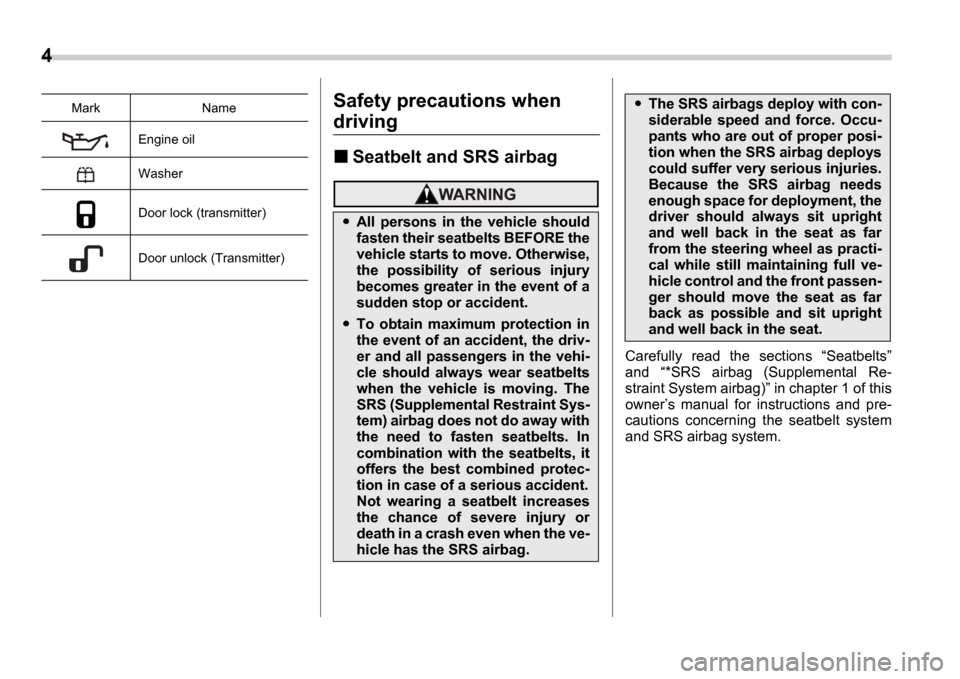
4
Safety precautions when
driving
Seatbelt and SRS airbag
Carefully read the sections Seatbelts
and *SRS airbag (Supplemental Re-
straint System airbag) in chapter 1 of this
owner s manual for instructions and pre-
cautions concerning the seatbelt system
and SRS airbag system.
Engine oil
Washer
Door lock (transmitter)
Door unlock (Transmitter)
Mark Name
All persons in the vehicle should
fasten their seatbelts BEFORE the
vehicle starts to move. Otherwise,
the possibility of serious injury
becomes greater in the event of a
sudden stop or accident.
To obtain maximum protection in
the event of an accident, the driv-
er and all passengers in the vehi-
cle should always wear seatbelts
when the vehicle is moving. The
SRS (Supplemental Restraint Sys-
tem) airbag does not do away with
the need to fasten seatbelts. In
combination with the seatbelts, it
offers the best combined protec-
tion in case of a serious accident.
Not wearing a seatbelt increases
the chance of severe injury or
death in a crash even when the ve-
hicle has the SRS airbag.
The SRS airbags deploy with con-
siderable speed and force. Occu-
pants who are out of proper posi-
tion when the SRS airbag deploys
could suffer very serious injuries.
Because the SRS airbag needs
enough space for deployment, the
driver should always sit upright
and well back in the seat as far
from the steering wheel as practi-
cal while still maintaining full ve-
hicle control and the front passen-
ger should move the seat as far
back as possible and sit upright
and well back in the seat.
Page 17 of 365

14
Instrument panel
7
6
5
4
3
2
1
15
16 14 12 10 11
13 9 8
000188
1) Door locks (page 2-4)
2) Outside mirror switch (page 3-34)
3) Light control lever (page 3-22)
4) Combination meter (page 3-11)
5) Wiper control lever (page 3-26)
6) Hazard warning flasher switch (page
3-6)
7) Audio (page 5-1)
8) Gear shift lever (5MT) (page 7-11)/
Gear shift lever (6MT) (page 7-9)/Se-
lector lever (AT) (page 7-16)
9) Climate control (page 4-1)
10) Cruise control (page 7-27)
11) Horn (page 3-35)
12) SRS airbag (page 1-35)
13) Tilt steering (page 3-35)
14) Fuse box (page 11-41)
15) Hood lock release knob (page 11-4)
16) Power windows (page 2-18)
Page 29 of 365

1-2 Seat, seatbelt and SRS airbags
Seat, seatbelt and SRS airbagsFront seats
Never adjust the seat while driv-
ing to avoid the possibility of loss
of vehicle control and of personal
injury.
Before adjusting the seat, make
sure the hands and feet of rear
seat passengers are clear of the
adjusting mechanism.
Seatbelts provide maximum re-
straint when the occupant sits
well back and upright in the seat.
To reduce the risk of sliding under
the seatbelt in a collision, the
front seatbacks should be always
used in the upright position while
the vehicle is running. If the front
seatbacks are not used in the up-
right position in a collision, the
risk of sliding under the lap belt
and of the lap belt sliding up over
the abdomen will increase, and
both can result in serious internal
injury or death.
The SRS airbags deploy with con-
siderable speed and force. Occu-
pants who are out of proper posi-
tion when the SRS airbag deploys
could suffer very serious injuries.
Because the SRS airbag needs
enough space for deployment, the
driver should always sit upright
and well back in the seat as far
from the steering wheel as practi-
cal while still maintaining full ve-
hicle control and the front passen-
ger should move the seat as far
back as possible and sit upright
and well back in the seat.
100082
Put children aged 12 and under in
the rear seat properly restrained at
all times. The SRS airbag deploys
with considerable speed and force
and can injure or even kill children,
especially if they are 12 years of age
and under and are not restrained or
improperly restrained. Because chil-
dren are lighter and weaker than
adults, their risk of being injured
from deployment is greater. Conse-
quently, we strongly recommend
that ALL children (including those in
child seats and those that have out-
grown child restraint devices) sit in
the REAR seat properly restrained
at all times in a child restraint device
or in a seatbelt, whichever is appro-
priate for the child s age, height and
weight. Secure ALL types of child
restraint devices (including forward
facing child seat) in the REAR seats
at all times.
NEVER INSTALL A REARWARD
FACING CHILD SEAT IN THE FRONT
SEAT. DOING SO RISKS SERIOUS
INJURY OR DEATH TO THE CHILD
BY PLACING THE CHILD S HEAD
TOO CLOSE TO THE SRS AIRBAG.
Page 40 of 365
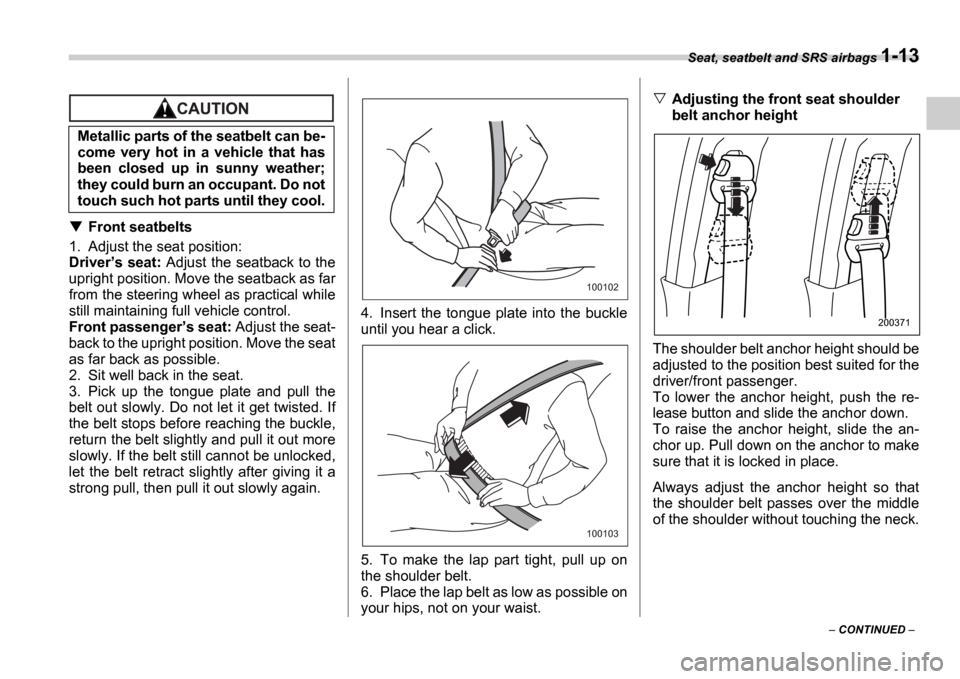
Seat, seatbelt and SRS airbags 1-13
CONTINUED
Front seatbelts
1. Adjust the seat position:
Driver s seat: Adjust the seatback to the
upright position. Move the seatback as far
from the steering wheel as practical while
still maintaining full vehicle control.
Front passenger s seat: Adjust the seat-
back to the upright position. Move the seat
as far back as possible.
2. Sit well back in the seat.
3. Pick up the tongue plate and pull the
belt out slowly. Do not let it get twisted. If
the belt stops before reaching the buckle,
return the belt slightly and pull it out more
slowly. If the belt still cannot be unlocked,
let the belt retract slightly after giving it a
strong pull, then pull it out slowly again. 4. Insert the tongue plate into the buckle
until you hear a click.
5. To make the lap part tight, pull up on
the shoulder belt.
6. Place the lap belt as low as possible on
your hips, not on your waist.
Adjusting the front seat shoulder
belt anchor height
The shoulder belt anchor height should be
adjusted to the position best suited for the
driver/front passenger.
To lower the anchor height, push the re-
lease button and slide the anchor down.
To raise the anchor height, slide the an-
chor up. Pull down on the anchor to make
sure that it is locked in place.
Always adjust the anchor height so that
the shoulder belt passes over the middle
of the shoulder without touching the neck.
Metallic parts of the seatbelt can be-
come very hot in a vehicle that has
been closed up in sunny weather;
they could burn an occupant. Do not
touch such hot parts until they cool.
100102
100103
200371
Page 63 of 365
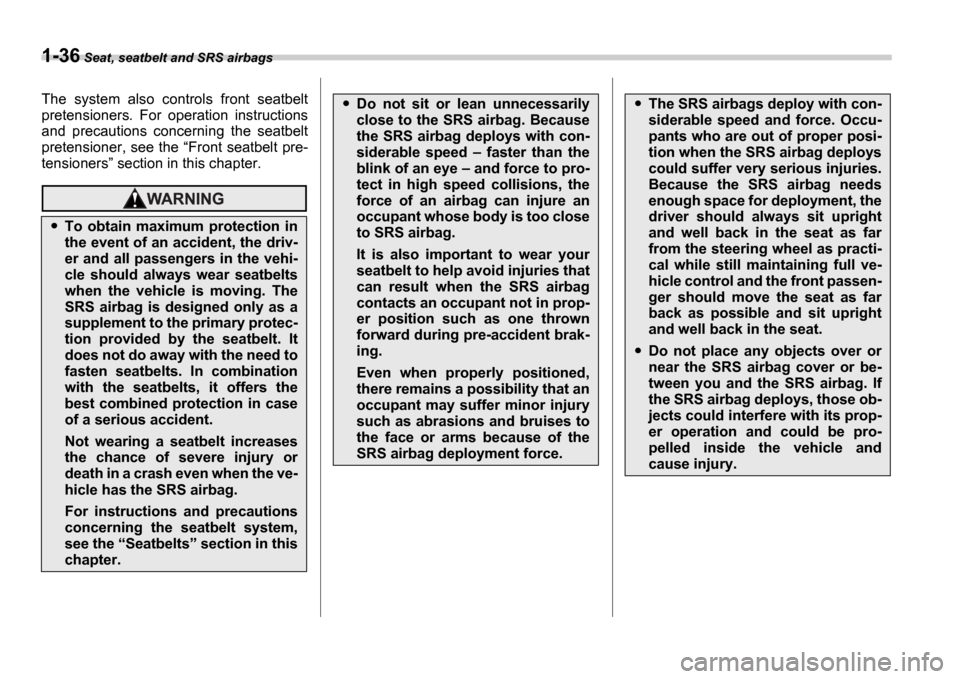
1-36 Seat, seatbelt and SRS airbags
The system also controls front seatbelt
pretensioners. For operation instructions
and precautions concerning the seatbelt
pretensioner, see the Front seatbelt pre-
tensioners section in this chapter.
To obtain maximum protection in
the event of an accident, the driv-
er and all passengers in the vehi-
cle should always wear seatbelts
when the vehicle is moving. The
SRS airbag is designed only as a
supplement to the primary protec-
tion provided by the seatbelt. It
does not do away with the need to
fasten seatbelts. In combination
with the seatbelts, it offers the
best combined protection in case
of a serious accident.
Not wearing a seatbelt increases
the chance of severe injury or
death in a crash even when the ve-
hicle has the SRS airbag.
For instructions and precautions
concerning the seatbelt system,
see the Seatbelts section in this
chapter.
Do not sit or lean unnecessarily
close to the SRS airbag. Because
the SRS airbag deploys with con-
siderable speed faster than the
blink of an eye and force to pro-
tect in high speed collisions, the
force of an airbag can injure an
occupant whose body is too close
to SRS airbag.
It is also important to wear your
seatbelt to help avoid injuries that
can result when the SRS airbag
contacts an occupant not in prop-
er position such as one thrown
forward during pre-accident brak-
ing.
Even when properly positioned,
there remains a possibility that an
occupant may suffer minor injury
such as abrasions and bruises to
the face or arms because of the
SRS airbag deployment force.
The SRS airbags deploy with con-
siderable speed and force. Occu-
pants who are out of proper posi-
tion when the SRS airbag deploys
could suffer very serious injuries.
Because the SRS airbag needs
enough space for deployment, the
driver should always sit upright
and well back in the seat as far
from the steering wheel as practi-
cal while still maintaining full ve-
hicle control and the front passen-
ger should move the seat as far
back as possible and sit upright
and well back in the seat.
Do not place any objects over or
near the SRS airbag cover or be-
tween you and the SRS airbag. If
the SRS airbag deploys, those ob-
jects could interfere with its prop-
er operation and could be pro-
pelled inside the vehicle and
cause injury.
Page 66 of 365
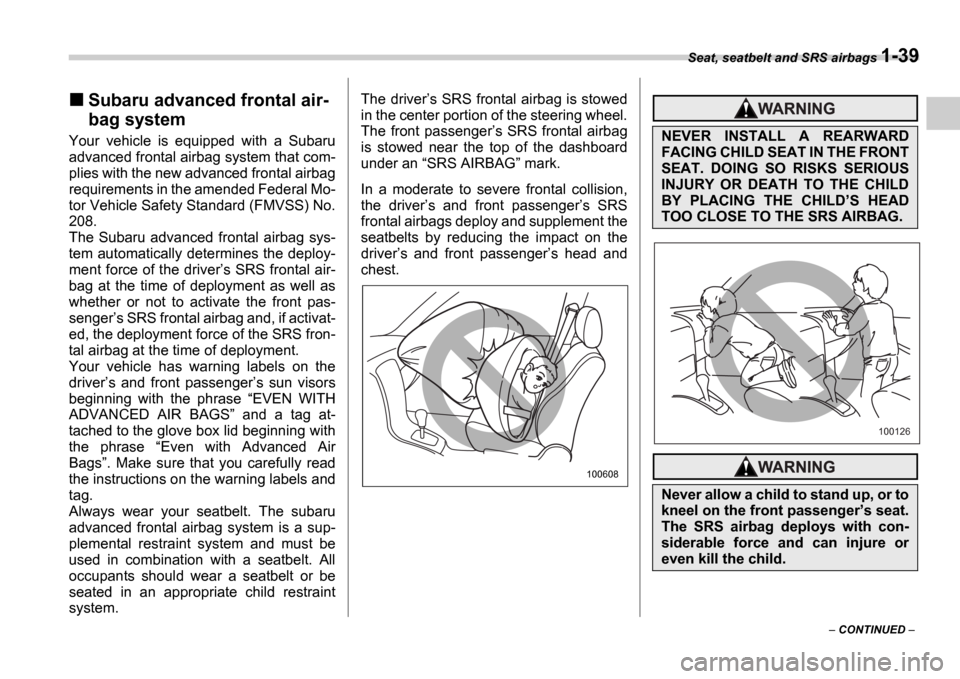
Seat, seatbelt and SRS airbags 1-39
CONTINUED
Subaru advanced frontal air-
bag system
Your vehicle is equipped with a Subaru
advanced frontal airbag system that com-
plies with the new advanced frontal airbag
requirements in the amended Federal Mo-
tor Vehicle Safety Standard (FMVSS) No.
208.
The Subaru advanced frontal airbag sys-
tem automatically determines the deploy-
ment force of the driver s SRS frontal air-
bag at the time of deployment as well as
whether or not to activate the front pas-
senger s SRS frontal airbag and, if activat-
ed, the deployment force of the SRS fron-
tal airbag at the time of deployment.
Your vehicle has warning labels on the
driver s and front passenger s sun visors
beginning with the phrase EVEN WITH
ADVANCED AIR BAGS and a tag at-
tached to the glove box lid beginning with
the phrase Even with Advanced Air
Bags . Make sure that you carefully read
the instructions on the warning labels and
tag.
Always wear your seatbelt. The subaru
advanced frontal airbag system is a sup-
plemental restraint system and must be
used in combination with a seatbelt. All
occupants should wear a seatbelt or be
seated in an appropriate child restraint
system. The driver
s SRS frontal airbag is stowed
in the center portion of the steering wheel.
The front passenger s SRS frontal airbag
is stowed near the top of the dashboard
under an SRS AIRBAG mark.
In a moderate to severe frontal collision,
the driver s and front passenger s SRS
frontal airbags deploy and supplement the
seatbelts by reducing the impact on the
driver s and front passenger s head and
chest.
100608
NEVER INSTALL A REARWARD
FACING CHILD SEAT IN THE FRONT
SEAT. DOING SO RISKS SERIOUS
INJURY OR DEATH TO THE CHILD
BY PLACING THE CHILD S HEAD
TOO CLOSE TO THE SRS AIRBAG.
Never allow a child to stand up, or to
kneel on the front passenger s seat.
The SRS airbag deploys with con-
siderable force and can injure or
even kill the child.
100126
Page 67 of 365
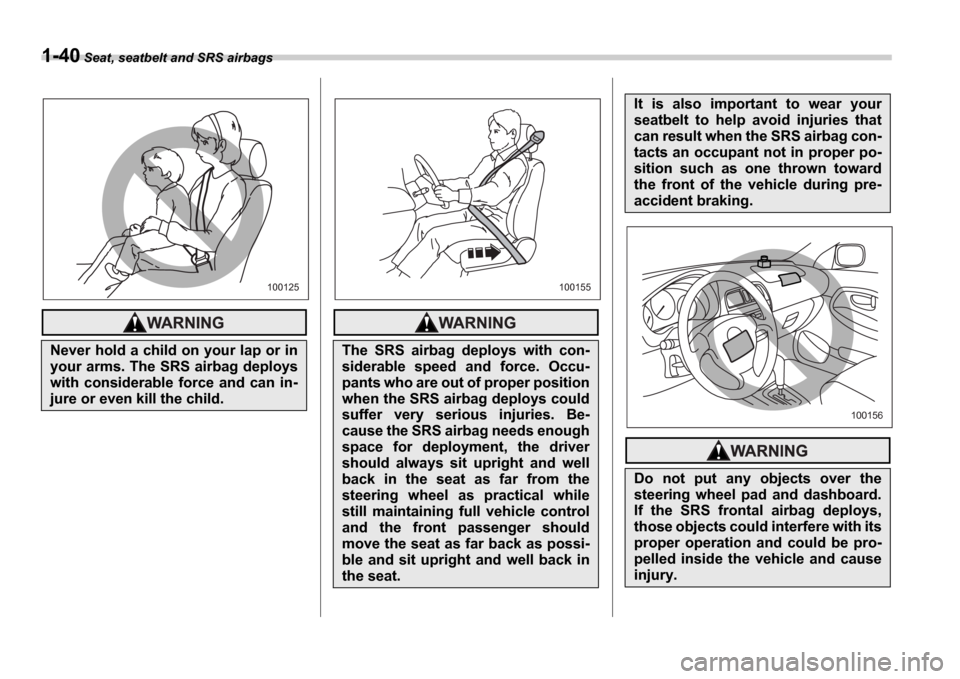
1-40 Seat, seatbelt and SRS airbags
Never hold a child on your lap or in
your arms. The SRS airbag deploys
with considerable force and can in-
jure or even kill the child.
100125
The SRS airbag deploys with con-
siderable speed and force. Occu-
pants who are out of proper position
when the SRS airbag deploys could
suffer very serious injuries. Be-
cause the SRS airbag needs enough
space for deployment, the driver
should always sit upright and well
back in the seat as far from the
steering wheel as practical while
still maintaining full vehicle control
and the front passenger should
move the seat as far back as possi-
ble and sit upright and well back in
the seat.
100155
It is also important to wear your
seatbelt to help avoid injuries that
can result when the SRS airbag con-
tacts an occupant not in proper po-
sition such as one thrown toward
the front of the vehicle during pre-
accident braking.
Do not put any objects over the
steering wheel pad and dashboard.
If the SRS frontal airbag deploys,
those objects could interfere with its
proper operation and could be pro-
pelled inside the vehicle and cause
injury.
100156
Page 72 of 365

Seat, seatbelt and SRS airbags 1-45
CONTINUED
When a heavy article is placed on the
seat.
When the front passenger s seat is occu-
pied by an adult, observe the following
precautions. Failure to do so may lessen
the load on the front passenger s seat, de-
activating the front passenger s SRS fron-
tal airbag despite the fact that the seat is
occupied by an adult.
Do not allow the rear seat occupant to
lift the front passenger s seat cushion us-
ing his/her feet.
Do not place any article under the front
passenger s seat, or squeeze any article
from behind and under the seat. This may
lift the seat cushion.
Do not squeeze any article between the
front passenger s seat and side trim/pillar,
door or center console box. This may lift
the seat cushion.
If the passenger s frontal airbag
OFF indicator illuminates and the
ON indicator extinguishes even
when the front passenger s seat is
occupied by an adult
This can be caused by the adult incorrect-
ly sitting in the front passenger s seat.
Turn the ignition switch to the OFF posi-
tion. Ask the front passenger to set the
seatback to the upright position, sit up
straight in the center of the seat cushion, correctly fasten the seatbelt, position his/
her legs out forward, and adjust the seat
to the rearmost position. Turn the ignition
switch to the
ON position. If the OFF in-
dicator remains illuminated while the ON
indicator remains extinguished, take the
following actions.
Turn the ignition switch to the OFF po-
sition.
Ensure that there is no article, book,
shoe, or other object trapped under the
seat, at the rear of the seat, or on the side
of the seat.
Ensure that the backward-forward posi-
tion and seatback of front passenger s
seat are locked into place securely by
moving the seat back and forth.
Next, turn the ignition switch to the ON
position and wait 6 seconds to allow the
system to complete self-checking. Follow-
ing the system check, both indicators ex-
tinguish for 2 seconds. Now, the ON indi-
cator should illuminate while the OFF indi-
cator remains extinguished.
If the OFF indicator still illuminates while
the ON indicator remains extinguished,
ask the occupant to move to the rear seat
and immediately contact your SUBARU
dealer for an inspection.
Effect vehicle modifications made
for persons with disabilities may
have on Subaru advanced frontal
airbag system operation (U.S. only)
Changing or moving any parts of the front
seats, seat belts, front bumper, front side
frame, instrument panel, combination
meter, steering wheel, steering column,
tire, suspension or floor panel can affect
the operation of the Subaru advanced air-
bag system. If you have any questions,
you may contact the following Subaru dis-
tributors:
Subaru of America, Inc.
Customer Dealer Services Department
P.O. Box 6000
Cherry Hill, NJ 08034-6000
1-800-SUBARU3 (1-800-782-2783)
Schuman Carriage Motors, Inc.
1234 South Beretania Street, Honolulu, HI
96814
808-592-4497
Triple J Enterprises, Inc.
P.O. Box 6066, Tamuning, Guam 96931
671-646-9126